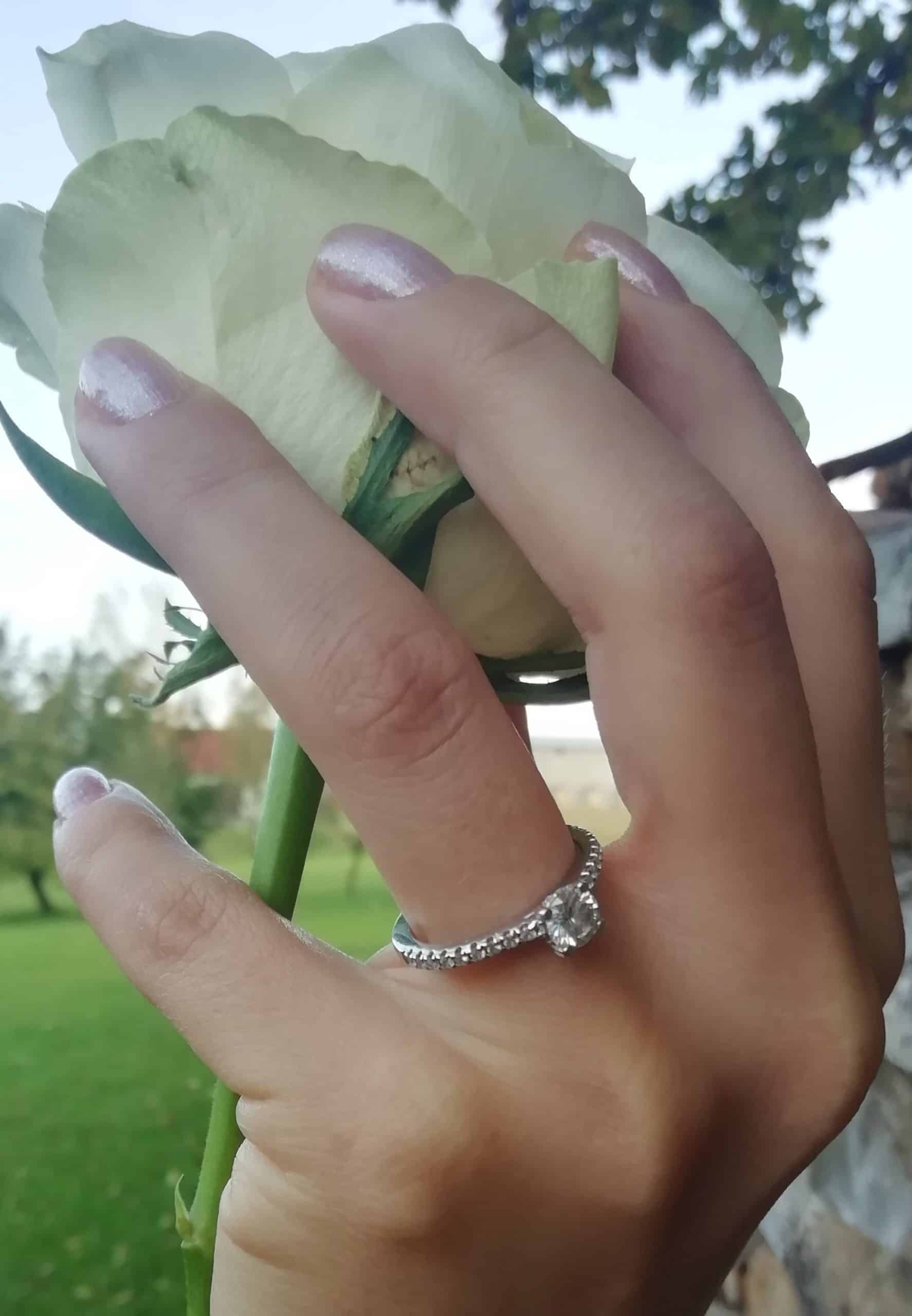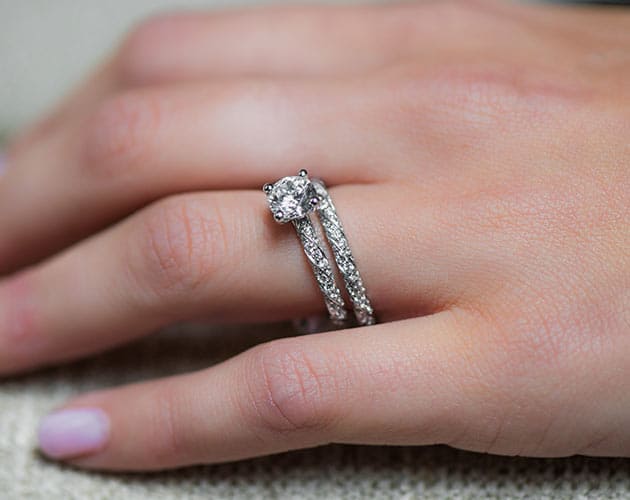We are reader-supported. Buying through any red colored link on our site may earn us commissions. Learn More.
Up to 40% off sidewide at James Allen!
In most Western traditions, the ring finger is the fourth finger on the left hand, next to the pinky finger. The tradition stems from ancient Greek and Roman times when it was believed that the fourth finger had a vein that led directly to the heart. A ring on this finger symbolized deep love. With modern knowledge of human anatomy, it’s now known that all fingers have veins that connect to the heart. Still, the tradition remains of wearing an engagement ring on the fourth finger of the left hand.
Look for an engagement ring online and browse all the styles there are. Sticking with a reputable vendor, such as Blue Nile or James Allen will help you get the best quality for a good price.

In Western tradition, wedding bands, such as these from Blue Nile, are generally also worn on the left-hand ring finger, the fourth finger next to the pinky. This again relates to the ancient belief that the finger had a direct vein to the heart.
If you’re wearing a wedding band and an engagement ring, they’re traditionally placed on the same finger. The wedding ring usually is worn closest to the heart (and palm of the hand), and the engagement ring closer to the knuckle. If you choose a matching wedding band, they can often look like one ring when placed next to each other. Look at this example of a twist curved diamond rings from Blue Nile.
Wedding bands are usually exchanged at wedding ceremonies in Western cultures. Before the ceremony, the engagement ring is often switched to the right hand, so the wedding band can go on the left-hand ring finger during the ceremony. Once the wedding ring is on the ring finger, the engagement ring is placed on top of it, so it sits closest to the knuckle. Some place their engagement ring next to the wedding ring during the ceremony, while others do it after the ceremony.
It’s important to remember that it’s OK not to follow Western tradition for how to wear your rings. While this tradition carries meaning to some couples, others choose their own path or follow a different cultural tradition. Many countries and cultures have different traditions for how to wear engagement and wedding rings. For example, in Russia and India, it’s common to wear both engagement and wedding bands on the right hand. The same goes for Spain, Portugal, and Hungary.
When it comes to deciding how to wear your rings, it’s important to do what’s meaningful for you and what is most comfortable. More and more couples are choosing their own path because it feels more genuine to them. They might wear their rings on the right hand, or on different fingers than the traditional ring finger. Some couples decide to solder their wedding ring and engagement rings together permanently. Others choose a bridal set, while others choose to forgo a wedding band and just wear their engagement ring. Ultimately, the style of your rings and which finger you wear them on is entirely up to you.
Yes, you can wear your engagement and wedding ring on your right hand
You can certainly wear your engagement ring on your right-hand ring finger. In fact, that’s the traditional way in several countries and cultures. In Norway, Russia, Poland, Denmark, Peru, Venezuela, and Columbia, it’s customary to wear your engagement ring on the right hand. In countries like Turkey and Brazil, it’s custom to wear your engagement ring on the right hand until the wedding, when it’s then switched to the left. And in Germany, the opposite happens: the engagement ring is worn on the left hand until the wedding ceremony when it’s then switched to the right.
Wearing your engagement ring on the right hand is a choice that many people make. Some people even wear their ring on the right hand because they are left-handed and want to avoid wear and tear on their ring.
You can also wear your wedding ring on the right hand. In countries across the world, from Poland and Bulgaria to Greece and Spain, couples wear their wedding bands on the right-hand ring finger. No matter how you style your rings and on which hand you wear them, it’s important that your ring size fits you. Your ring size should be comfortable. The ring shouldn’t be too loose that you risk it sliding off, or too tight where it feels uncomfortable to wear every day.
Wedding Ring – For your right hand or left hand?

In Western culture, it’s traditional to wear your wedding ring on the left hand, though some wear it on their right. While the left-hand finger stems from an ancient belief, the right hand has its own significance, especially in modern times. For example, as many women now earn as much or more than men, women have enough income to buy their own diamond rings. They often wear them on their right hands to show their financial prosperity and success. As another example, gay and lesbian couples often opt to wear their rings on their right hands, instead of their left. More people are also embracing different cultural traditions, reflecting their heritage. And if you’re left-handed, you might prefer to wear your ring on your right hand so your ring is less subject to wear and tear.
Both men and women choose to wear their rings on their right hands, just as both men and women also wear rings on the left hand. The choice is personal and can reflect your own culture, style, symbolism, or comfort.
How Wedding and Engagement Rings Go Together
Most people wear their engagement ring and wedding ring on the same finger, especially in Western culture. Before the wedding ceremony, it’s tradition to wear your engagement ring on your left-hand ring finger. At the ceremony, it’s common to put the wedding ring on the left-hand ring finger closest to the palm and slide the engagement ring on top so it’s closest to the knuckle. If there’s no engagement ring, the wedding band often sits by itself on the left-hand ring finger.
In other cultures, it’s traditional for rings to be worn together as well, but on the right hand. As an example, in many European countries including Spain and Greece, the custom is to wear your engagement ring and wedding ring on the right hand. In Brazil and Turkey, engagement rings stay on the right hand until the wedding, when they’re switched to the left hand.
Others, no matter their culture, choose to wear their rings on separate fingers or only wear one ring. For instance, you can wear your engagement ring and wedding ring on different fingers, and even on different hands if you want. As an example, you might wear your wedding ring on your left hand, and place your engagement ring on your right.
Can rings be worn on different fingers?
Yes, your engagement ring and wedding ring can be worn on different fingers. For instance, some couples place their wedding ring on their left-hand ring finger and their engagement ring on their right-hand ring finger. You can also wear your rings on different fingers of the same hand.
You may choose to wear your rings on different fingers for comfort or style or because it reduces wear and tear. Ultimately, how you wear your rings is up to you. Just like a unique engagement ring, how you wear your rings is a way to showcase your personal style.

- No questions asked returns within 30 days of shipment. James Allen will send you a paid shipping label to return the ring.
- Lifetime Warranty
- Free International Shipping
- Free prong tightening, repolishing, rhodium plating and cleaning every 6 months
- Provide insurance appraisals
- One free resizing within 60 days of purchase
- Free ring inscriptions
- Best-in-class high quality imagery of all diamonds in stock
- 24/7 Customer Service
- Best-in-class packaging


- No questions asked returns within 30 days of shipment. Blue Nile will send you a paid shipping label to return the ring.
- Lifetime Warranty
- Free Shipping
- Free prong tightening, repolishing, rhodium plating and cleaning every 6 months
- Provide insurance appraisal
- One free resizing within the first year of purchase
- High quality images of about half of their diamonds
- 24/7 Customer Service
- 100% credit towards future upgrades (must be at least double in value)
- Best in class fulfillment

Still afraid of getting ripped off?
Before you buy a diamond, get personal buying advice from industry veterans. We'll help you get the best diamond for the money.
Ask your diamond purchase question here
DISCLAIMER: We don't use your email for marketing. Period.
You Might Like
Diamond Prices: A Complete Guide
A diamonds’ price is determined primarily by the 4 Cs of the diamond. On the wholesale level, diamond prices are first based on a diamond shape and
The Best Places to Buy Engagement Rings
Buying an engagement ring is often one of the first major purchases in a person's life. The process can be fraught with tension as there are so m
1 Carat Diamond Price & Buying Guide
A wide range of 1 carat diamonds exist both in online markets and local diamond jewelry stores. Not only are there significant differences in beauty

